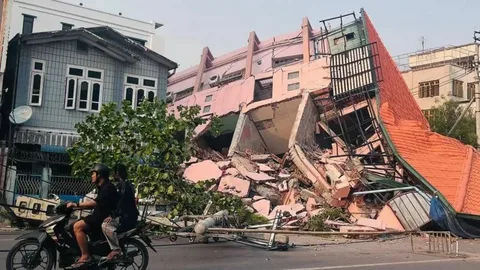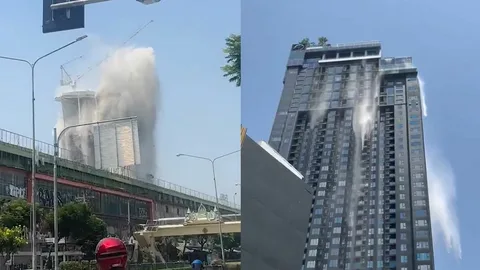Myanmar Shaken by Aftershocks as Bangkok Collapse Deaths Rise

Myanmar Shaken by Aftershocks, causing widespread panic and damage, as the country reels from a powerful earthquake. Meanwhile in Bangkok, a tragic building collapse has claimed multiple lives, raising concerns about construction safety and emergency preparedness in the region.
These events highlight the seismic risks that Southeast Asia faces, prompting discussions about disaster resilience and humanitarian response efforts.
Table of Contents
Myanmar Earthquake and Aftershocks
On [28 March 2025], a significant earthquake struck Myanmar, sending tremors across the country and beyond. The quake, measuring [magnitude] on the Richter scale, was centered near [epicenter location], affecting thousands of residents. Myanmar Shaken by Aftershocks as the initial shock was followed by multiple tremors, compounding the fear and damage.
Residents reported buildings swaying, walls cracking, and infrastructure failing in several towns and cities. While some areas experienced power outages, emergency response teams were quickly deployed to assess the damage and aid those affected.
The full extent of casualties and destruction is still being determined, but authorities are urging citizens to remain cautious as Myanmar Shaken by Aftershocks continues.
Bangkok Building Collapse

In a separate but equally devastating incident, a building in Bangkok collapsed, leading to multiple fatalities and injuries.
Preliminary reports suggest that structural weaknesses, possibly exacerbated by recent seismic activity, may have contributed to the disaster.
Rescue teams worked tirelessly to pull survivors from the rubble, with local hospitals overwhelmed by the influx of injured victims.
Witnesses described scenes of chaos as people scrambled to safety, highlighting concerns over construction standards and enforcement of safety regulations in the rapidly developing city.
Authorities are investigating the cause of the collapse, with experts calling for stricter oversight in the construction industry to prevent future tragedies.
The disaster serves as a grim reminder of the need for better urban planning and disaster preparedness in regions vulnerable to earthquakes.
Seismic Risks and Safety Concerns
Myanmar and Thailand sit along fault lines that make them susceptible to earthquakes. While Myanmar experiences frequent seismic activity due to its position near the convergence of tectonic plates, Thailand is less prone but not entirely immune.
Experts warn that poor infrastructure and lax safety regulations exacerbate the risks posed by even moderate quakes.
In Myanmar, many older buildings are not constructed to withstand significant tremors, putting residents at risk. In Thailand, rapid urbanization has led to construction practices that sometimes prioritize cost-cutting over safety.
Myanmar Shaken by Aftershocks has further emphasized the urgent need for improved building codes, early warning systems, and public awareness campaigns on earthquake preparedness.
History of Earthquakes in the Region
Southeast Asia has experienced several major earthquakes, particularly in Myanmar and Thailand. Myanmar’s 2016 quake damaged Bagan’s temples, while the 2011 tremor caused multiple fatalities. Thailand’s 2014 Chiang Rai earthquake also led to significant infrastructure damage. These events highlight the need for stricter building regulations and disaster preparedness.
| Year | Location | Magnitude | Impact |
|---|---|---|---|
| 2016 | Bagan, Myanmar | 6.8 | Damaged temples |
| 2011 | Myanmar | 6.8 | Dozens killed |
| 2014 | Chiang Rai, Thailand | 6.0 | Infrastructure damage |
Humanitarian Response and Aid Efforts

In the wake of these disasters, humanitarian organizations and governments have mobilized to provide relief to affected communities.
Emergency shelters, food supplies, and medical aid are being distributed in Myanmar, where thousands have been displaced due to damaged homes and infrastructure.
In Bangkok, emergency responders, alongside volunteers, are assisting survivors and families affected by the building collapse. The Thai government has pledged support for those impacted, while international organizations are offering expertise in structural safety and disaster recovery.
Social media and crowdfunding campaigns have also played a crucial role in raising funds and awareness, demonstrating the power of digital platforms in disaster response efforts.
Conclusion
The recent earthquake in Myanmar and the tragic building collapse in Bangkok serve as stark reminders of the vulnerabilities many communities face in Southeast Asia.
Myanmar Shaken by Aftershocks highlights the urgent need for stronger building regulations, improved disaster preparedness, and more effective emergency response strategies.
As governments and organizations work to mitigate future risks, public awareness and preparedness remain crucial. Investing in safer infrastructure enforcing stricter regulations and educating communities on earthquake safety can save lives and reduce the devastating impact of such disasters in the future.






